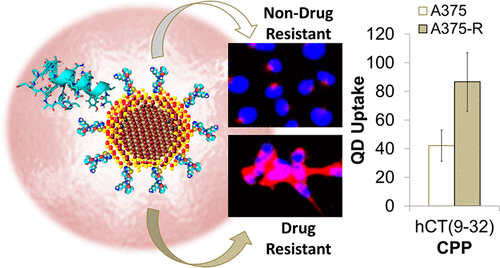当前位置:
X-MOL 学术
›
Bioconjugate Chem.
›
论文详情
Our official English website, www.x-mol.net, welcomes your
feedback! (Note: you will need to create a separate account there.)
Selective Uptake Into Drug Resistant Mammalian Cancer by Cell Penetrating Peptide-Mediated Delivery
Bioconjugate Chemistry ( IF 4.0 ) Pub Date : 2018-09-21 00:00:00 , DOI: 10.1021/acs.bioconjchem.8b00429 Kate J. F. Carnevale 1 , Megan E. Muroski 1 , Parth N. Vakil 1 , Megan E. Foley 1 , Geoffry Laufersky 1 , Rachael Kenworthy 1 , Diego A. R. Zorio 2 , Thomas J. Morgan 2 , Cathy W. Levenson 2 , Geoffrey F. Strouse 1
Bioconjugate Chemistry ( IF 4.0 ) Pub Date : 2018-09-21 00:00:00 , DOI: 10.1021/acs.bioconjchem.8b00429 Kate J. F. Carnevale 1 , Megan E. Muroski 1 , Parth N. Vakil 1 , Megan E. Foley 1 , Geoffry Laufersky 1 , Rachael Kenworthy 1 , Diego A. R. Zorio 2 , Thomas J. Morgan 2 , Cathy W. Levenson 2 , Geoffrey F. Strouse 1
Affiliation

|
Research over the past decade has identified several of the key limiting features of multidrug resistance (MDR) in cancer therapy applications, such as evolving glycoprotein receptors at the surface of the cell that limit therapeutic uptake, metabolic changes that lead to protection from multidrug resistant mediators which enhance degradation or efflux of therapeutics, and difficulty ensuring retention of intact and functional drugs once endocytosed. Nanoparticles have been demonstrated to be effective delivery vehicles for a plethora of therapeutic agents, and in the case of nucleic acid based agents, they provide protective advantages. Functionalizing cell penetrating peptides, also known as protein transduction domains, onto the surface of fluorescent quantum dots creates a labeled delivery package to investigate the nuances and difficulties of drug transport in MDR cancer cells for potential future clinical applications of diverse nanoparticle-based therapeutic delivery strategies. In this study, eight distinct cell penetrating peptides were used (CAAKA, HSV1-VP22, HIV-TAT, HIV-gp41, Ku-70, hCT(9-32), integrin-β3, and K-FGF) to examine the different cellular uptake profiles in cancer versus drug resistant melanoma (A375 & A375-R), mesothelioma (MSTO & MSTO-R), and glioma (rat 9L and 9L-R, and human U87 & LN18) cell lines. The results of this study demonstrate that cell penetrating peptide uptake varies with drug resistance status and cell type, likely due to changes in cell surface markers. This study provides insight into developing functional nanoplatform delivery systems in drug resistant cancer models.
中文翻译:

通过细胞穿透肽介导的传递选择性摄取到抗药性哺乳动物。
过去十年的研究已经确定了多药耐药性(MDR)在癌症治疗应用中的几个关键限制特征,例如,细胞表面不断发展的糖蛋白受体的发展限制了药物的吸收,新陈代谢的变化导致了对多药耐药性介质的保护会加速治疗药物的降解或外排,并难以确保内吞后保留完整和功能性药物。已经证明纳米颗粒是用于多种治疗剂的有效递送载体,并且在基于核酸的试剂的情况下,它们提供了保护性优点。功能化细胞穿透肽,也称为蛋白质转导结构域,在荧光量子点表面上形成一个标记的递送包装,以研究MDR癌细胞中药物运输的细微差别和困难,以用于基于纳米粒子的多种治疗性递送策略的潜在未来临床应用。在这项研究中,使用了八个不同的细胞穿透肽(CAAKA,HSV1-VP22,HIV-TAT,HIV-gp41,Ku-70,hCT(9-32),整联蛋白-β3和K-FGF)来检查不同的癌细胞与耐药性黑色素瘤(A375和A375-R),间皮瘤(MSTO和MSTO-R)和神经胶质瘤(大鼠9L和9L-R和人U87和LN18)细胞系的细胞摄取概况。这项研究的结果表明,细胞穿透肽的摄取随耐药状态和细胞类型的变化而变化,这可能是由于细胞表面标志物的变化所致。
更新日期:2018-09-21
中文翻译:

通过细胞穿透肽介导的传递选择性摄取到抗药性哺乳动物。
过去十年的研究已经确定了多药耐药性(MDR)在癌症治疗应用中的几个关键限制特征,例如,细胞表面不断发展的糖蛋白受体的发展限制了药物的吸收,新陈代谢的变化导致了对多药耐药性介质的保护会加速治疗药物的降解或外排,并难以确保内吞后保留完整和功能性药物。已经证明纳米颗粒是用于多种治疗剂的有效递送载体,并且在基于核酸的试剂的情况下,它们提供了保护性优点。功能化细胞穿透肽,也称为蛋白质转导结构域,在荧光量子点表面上形成一个标记的递送包装,以研究MDR癌细胞中药物运输的细微差别和困难,以用于基于纳米粒子的多种治疗性递送策略的潜在未来临床应用。在这项研究中,使用了八个不同的细胞穿透肽(CAAKA,HSV1-VP22,HIV-TAT,HIV-gp41,Ku-70,hCT(9-32),整联蛋白-β3和K-FGF)来检查不同的癌细胞与耐药性黑色素瘤(A375和A375-R),间皮瘤(MSTO和MSTO-R)和神经胶质瘤(大鼠9L和9L-R和人U87和LN18)细胞系的细胞摄取概况。这项研究的结果表明,细胞穿透肽的摄取随耐药状态和细胞类型的变化而变化,这可能是由于细胞表面标志物的变化所致。











































 京公网安备 11010802027423号
京公网安备 11010802027423号